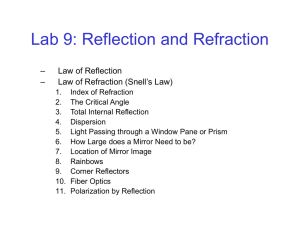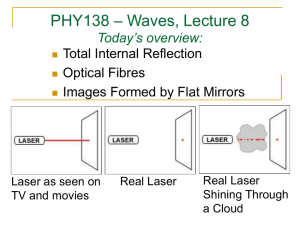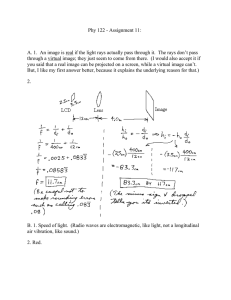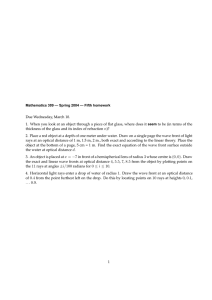12. Light Rays and Optical Index*
advertisement
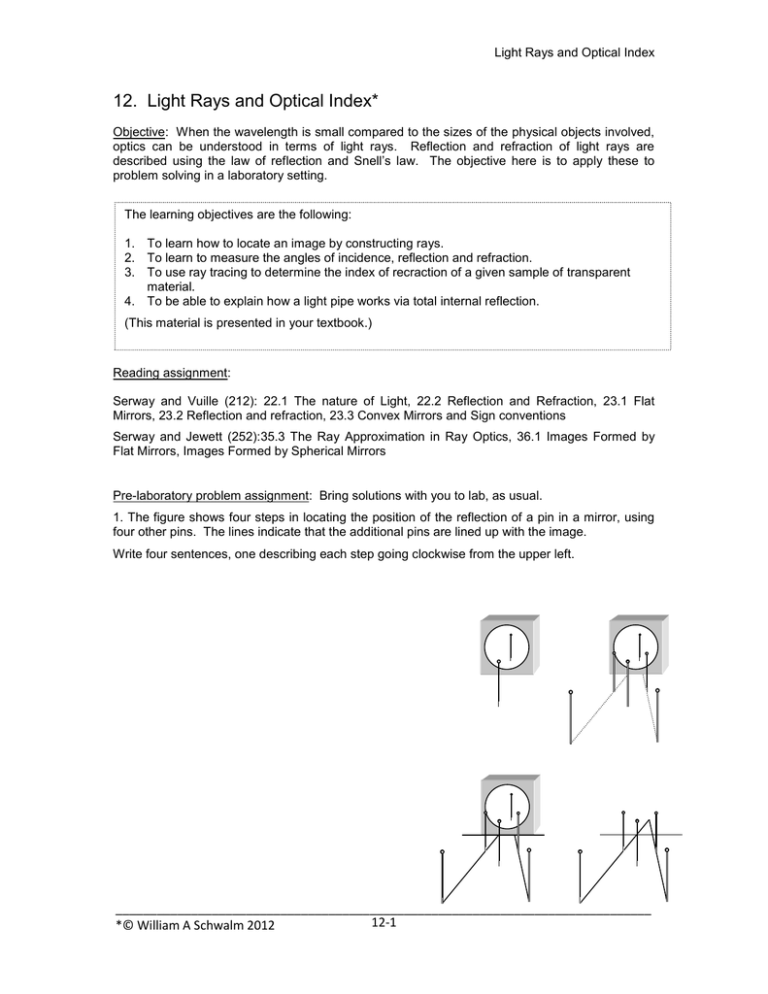
Light Rays and Optical Index 12. Light Rays and Optical Index* Objective: When the wavelength is small compared to the sizes of the physical objects involved, optics can be understood in terms of light rays. Reflection and refraction of light rays are described using the law of reflection and Snell’s law. The objective here is to apply these to problem solving in a laboratory setting. The learning objectives are the following: 1. To learn how to locate an image by constructing rays. 2. To learn to measure the angles of incidence, reflection and refraction. 3. To use ray tracing to determine the index of recraction of a given sample of transparent material. 4. To be able to explain how a light pipe works via total internal reflection. (This material is presented in your textbook.) Reading assignment: Serway and Vuille (212): 22.1 The nature of Light, 22.2 Reflection and Refraction, 23.1 Flat Mirrors, 23.2 Reflection and refraction, 23.3 Convex Mirrors and Sign conventions Serway and Jewett (252):35.3 The Ray Approximation in Ray Optics, 36.1 Images Formed by Flat Mirrors, Images Formed by Spherical Mirrors Pre-laboratory problem assignment: Bring solutions with you to lab, as usual. 1. The figure shows four steps in locating the position of the reflection of a pin in a mirror, using four other pins. The lines indicate that the additional pins are lined up with the image. Write four sentences, one describing each step going clockwise from the upper left. ______________________________________________________________________________ 12-1 *© William A Schwalm 2012 Light Rays and Optical Index 2. The data from the experiment above are as follows: The four dark specks are pin holes from the four auxiliary pins used to locate the image of the object pin shown. The horizontal line was drawn parallel to the reflecting surface of the mirror. (a) Using a ruler determine the position of the image. Show your construction. (b) Think of the lines you drew as light rays that seem to come from the image. Show by adding two more lines how these light rays have actually come from the object and have been reflected at the mirror’s surface. (c) Now add two more lines normal (perpendicular) to the mirror surface and thus demonstrate how each of these two rays obeys the law of reflection (which of course you must state.) 3. From your reading, give the definition of the index of refraction, or optical index n of a material as a ratio of two speeds. 4. Give Snell’s law of refraction. Define each symbol and explain how (from which reference direction) each angle must be measured. 5. Describe the phenomenon of total internal refection (TIR). Starting from Snell’s law, explain how you can arrive at a formula for the critical angle for TIR. 12-2 Light Rays and Optical Index Problem 1 You have read in your textbook that the image reflected in a plane mirror is behind the mirror by the same distance as the object is in front of the mirror. You need to demonstrate this, and to explain how it results from the law of reflection. The idea is to actually perform the experiment described in the pre-lab exercise. You will need to use some geometry. Apparatus: The apparatus is simple. You have a mirror mounted to a wooden block, a wooden drawing board, a sheet or two of drawing paper, several pins, a ruler and a protractor. In-lab group activities: 1. In this experiment you need to know how the mirror works. Examine the mirror and decide whether the reflection occurs at the front surface or the back surface of the glass. Record your decision and give the observational reasons for your conclusion here. Measurement plan: through group discussion, decide on a plan for doing the assigned work. Address details, such as how you will know when two auxiliary pins actually line up with the image pin. How will you observe this and what should you see when you look? Your plan should list what you will do to fulfill each part of the assignment, what data you need, how you will get it and how all the group members will be utilized. Implementation: Carry out your plan and record the data. The data should include (among other stuff) either the original paper with lines and pin holes on it, or a photocopy distributed to the group members for inclusion with the report. Include notes and comment as necessary. 12-3 Light Rays and Optical Index Summary: Summarize what has been demonstrated in your own words. Include a statement of how this activity has related to the law of reflection and to the learning objectives. Problem 2 Barrow Optical is contracted to produce a heads-up display involving a light pipe. A light pipe consists of a rod or fiber of transparent material in which light travels along the rod by means of total internal reflection at the surface. The material the light pipe will be made of is a new acrylic. You have samples in the form of rectangular blocks. Your group needs to determine the optical index of the acrylic, calculate the critical angle for TIR and then work on a design problem (see below) related to the light pipe. In-class: Consider a diagram of the block showing from above the positions of four pins that appear to line up when viewed as shown. 1. Construct normal lines at appropriate points and label four relevant angles. 2. Snell’s law relates two pairs of angles. Write down the two equations that come from Snell’s law, assuming the index in air is approximately 1, and using n for the index in the acrylic. 12-4 Light Rays and Optical Index 3. What does geometry tell you? Which two angles are equal due to a theorem about parallel lines? State the theorem and write the equation that follows from it. 4. The basic laws of electromagnetism are “time reversal symmetric,” which implies a light ray is always reversible. You can interchange the source and the observer and have an equally valid light ray. Does this give you another equation? If so, write it here. If not, explain. 5. Use the information above to solve for the index of refraction of the imaginary block in the figure by measuring the angles with a protractor. n = ? Measurement plan: Your group needs to work out a plan to measure the optical index of the actual acrylic material. From this value of n you should predict the critical angle for TIR in a light pipe made of this material. Be sure to include a way to estimate the degree of error involved. Can you think of a rough check for the critical angle? Record your plan here, including all the usual details. Implementation: Carry out your plan. Measure the relevant angles and record the necessary data. Make note of any other activities relating to the measurements. 12-5 Light Rays and Optical Index Analysis: Compute the index of the acrylic plastic and carry out your estimate of the degree of error. As usual, you must justify this estimate to your supervisor. Make it clear how the estimate was arrived at. Finally, calculate the critical angle and estimate how much error there is in your result. Again you must explain. (You know this by now.) Conclusion: At the end of class, there should be a brief discussion of how the laboratory activities have addressed the learning objectives. Record the interesting comments from the class and add your own comments here. Take-home problem: (Phys 252) To construct a light pipe we want to make it so light can’t hit the sides at an angle less than the critical angle, so that the light is always totally reflected along the pipe. You have measured the index n of the clear acrylic material the pipe is made of, and that the thickness if the acrylic is a . We observe that when a light ray just skims along tangent to the inner surface of the acrylic, as shown, it makes the largest angle of incidence with the outer surface (worst case). What is the minimum radius of curvature r the pipe can have? You may consult with your lab partners, but include a solution based on your measurements with the laboratory report. (Hint: If A is the center of curvature, then lines from A are radial. So if the light ray shown is tangent to the inner surface at point B, what angle does it make with the extra dashed line from A?) C r B A Extra line 12-6 a

